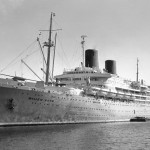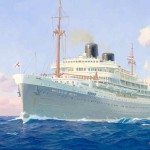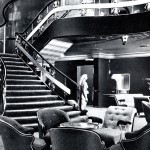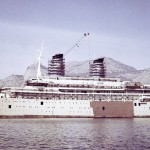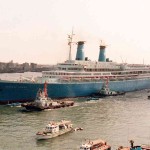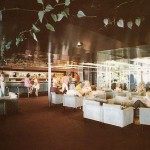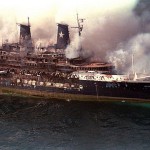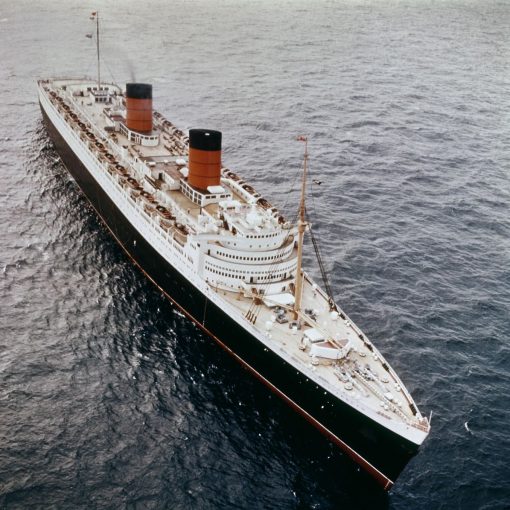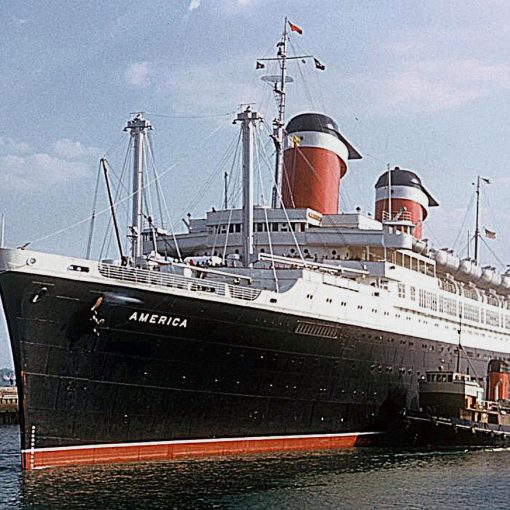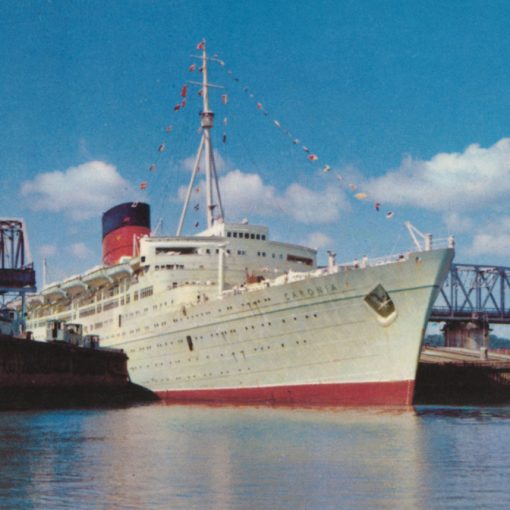1947 – 1994
Also known as Achille Lauro
While large shipping companies such as Cunard White Star and the French Line rebuilt their reduced fleets after World War II, smaller companies also sought the way to success. In the Netherlands, the famous Holland America Line operated the route to North America. Great Dutch ships as the Nieuw Amsterdam had hit the waves within the last decade, and she had become an immediate success.
Two smaller Dutch shipping companies – the Nederlandsche SB Mij. and the Rotterdamsche Lloyd – were aiming at the East India route. Nederlandsche SB Mij. had introduced their Oranje in 1939. Her maiden voyage to Indonesia had been very popular, and now the Rotterdamsche Lloyd needed to compete with a similar liner on the same route.
In January 1939 the keel of a 20,000 gross ton liner was laid at the De Schelde shipyard in Vlissingen for Rotterdamsche Lloyd. However, the outbreak of war later that year halted the construction of the ship. While still on the slipway, the Germans bombed the future liner, and they subsequently took her over and continued construction for themselves. But continued construction was frequently sabotaged by the Dutch resistance, and stopped by Royal Air Force bombing. Eventually, the Germans abandoned the ship, who seemed to have no other future than a trip to the scrappers. For the rest of the war, the devastated hull remained undisturbed.
When peace returned to Europe, Rotterdamsche Lloyd decided to put the liner in service despite the damage she had suffered during the past years. The completion was considered a national priority. And so, on July 1, 1946 the ship was launched and christened Willem Ruys after the founder of the Rotterdamsche Lloyd. It took until November 21, 1947 until the vessel had been completed, and on December 2, 1947 she set out on her maiden voyage from Rotterdam to Indonesia. By now, Holland’s Queen Wilhelmina had granted the company a ‘royal prefix’ for its services during the war, thus becoming Royal Rotterdam Lloyd. The Willem Ruys became a popular ship on the Indonesia service – Rotterdamsche Lloyd had succeeded in creating a worthy rival to the Oranje.
But the Willem Ruys’ success depended much on the Dutch relationship with Indonesia. This group of islands had been a Dutch colony since the 17th century, but in 1949 the area gained its independence. This greatly reduced the passenger traffic between the Netherlands and Indonesia. The Willem Ruys became less successful, and it was considered to move her to the more profitable North Atlantic run. Before she was transferred in May 1958, she had suffered a collision with her rival, Oranje. Fortunately, there was no loss of life in the event.
After the Willem Ruys had served for some time on the New York run, she was put on the Canadian service and later on the route to New Zealand via the Suez Canal. Before she entered the New Zealand route, she had been rebuilt by Wilton-Fijenoord to fit in the round the world service.
Because of a heavy drop in passenger traffic, the Willem Ruys was sold to the Italian shipping company Lauro Line. The same year, the old rival Oranje was also sold to the Lauro Line. The Willem Ruys was delivered to the line in December that year. In January 1965, she was officially handed over and renamed Achille Lauro after the managing director of the Lauro Line.
Work began to rebuild and modernise the liner by CN Riuniti di Palermo. Unfortunately, the vessel suffered an explosion and a resulting fire on August 29, and work was thereby much delayed. Not until April 13, 1966 did the Achille Lauro enter service again. The most obvious changes made to her were the heightening of the two funnels, and the repainting of the hull into blue. The gross tonnage had been increased to 23,629, and the first voyage went to Wellington from Genoa via Sydney. She continued as a fairly popular ship in the Lauro Line for another six years without any major event. However, on May 19, 1972 the ship was badly damaged by fire during an overhaul at Genoa. It took five months before Achille Lauro could enter service again. In December 1972, her service to Oceania ended and she was to cruise only hereafter.
The Achille Lauro served for another uneventful three years before a shaking event occurred. On April 28, 1975 she accidentally rammed the small Lebanese cattle carrier Youssef in the Dardanelles. The accident resulted in one human casualty. The next serious accident happened in 1981, when the ship suffered yet another fire. The blaze did not send the ship to the scrappers, however, but she was put into service again later. In 1982, she was seized by the authorities because the owners had not paid the port duties. At the time she was on her way home from a cruise, and she was stopped in Tenerife for several months before she could return to Genoa. There, she was laid up until the Lauro Line could pay their debts.
In 1985, the Lauro Line merged with the Chandris Line. In this new company’s service, the Achille Lauro entered the history books that same year. On October 7, 1985 the Achille Lauro was employed on a ten-day cruise. She was supposed to call at Alexandria in order to allow passengers to go to Cairo, and then rejoining the ship at Port Said. Only about half of the passengers went ashore, while the rest stayed on board to enjoy the ship. During the trip from Alexandria to Port Said, the ship was taken hostage by five Palestinian terrorists. This was the first time in history a passenger ship was hijacked like this. The terrorists showed their seriousness – and madness – when they killed the disabled American tourist Leon Klinghoffer, and threw him and his wheelchair overboard. The Egyptian authorities gave the hijackers permission to leave the area without harassment, and the Achille Lauro soon arrived at Port Said. The hijackers left the ship onto a tugboat and made a victory lap around the harbour. They left victorious in an aeroplane, but the American authorities would not accept this and forced the plane down over Sicily. The Egyptian government retained the liner in retaliation. Yet again, the Achille Lauro suffered the repercussions of a crisis that had a great effect on American-Egyptian relations. Eight days later, the Achille Lauro returned to her homeport.
In 1987, the Achille Lauro took on the Swiss flag, under the care of the Star Lauro company. Two years later, a movie was released called ‘The Hijack of the Achille Lauro’. It starred Karl Malden and tried to reflect the event that had taken place four years earlier. Since the Achille Lauro was not available during the filming, many exterior shots showed other liners and especially cargo ships.
The end of the ship came a few years later. On December 2, 1994 she was cruising in the seas off Somalia when she once again suffered a fire. This time, it was so devastating that all 1,090 passengers and crew had to be taken off. Of them, three people were killed in the blaze before they could be rescued. The fire lasted for three days and the ship was declared a total loss.
Specifications
- 631 feet (192.8 m) long
- 82.3 feet (25.1 m) wide
- 21,119 gross tons
- Eight diesel engines powering two propellers
- 22 knot service speed
- Passenger capacity of 900 people

